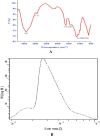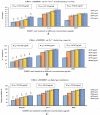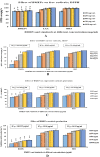Characterization and in-vitro Alzheimer's properties of exopolysaccharide from Bacillus maritimus MSM1
- PMID: 37452077
- PMCID: PMC10349148
- DOI: 10.1038/s41598-023-38172-z
Characterization and in-vitro Alzheimer's properties of exopolysaccharide from Bacillus maritimus MSM1
Abstract
Four bacterial isolates were obtained from marine sediments collected from Sahl Hashish, Hurghada Red Sea, Egypt. This study was designed to search for promising anti-Alzheimer natural polysaccharide; therefore, four isolates were screened for exopolysaccharides (EPSs) production and acetylcholinesterase inhibition. The isolate S16 provided the highest EPS yield (7.51 g/L) and acetylcholinesterase inhibition. It was identified morphologically and genetically using 16S rRNA gene sequence analysis as Bacillus maritimus. A Physicochemical analysis of S16 exopolysaccharide (BMEPS) was estimated, which pointed to the presence of uronic acid and sulfate (24.7% and 18.3%, respectively). HPLC analysis indicated that mannuronic acid, glucuronic acid, glucose, and mannose are presented in a molar ratio of 0.8:1.0:2.8:2.3, respectively. Furthermore, FT-IR revealed an abundance of β-configurations. The GPC estimated the average molecular weight (Mw) as 4.31 × 104 g/mol. BMEPS inhibited AChE (IC50; 691.77 ± 8.65 μg/ ml), BChE (IC50; 288.27 ± 10.50 μg/ ml), and tyrosinase (IC50; 3.34 ± 0.09, 14.00 ± 0.14, and 22.96 ± 1.23 μg/ ml during incubation durations of 10, 20, and 40 min). It also demonstrated a selective anti-inflammatory action against COX-2 rather than COX-1. Moreover, BMEPS exhibited antioxidant capabilities as free radical and oxygen reactive species (ROS) scavenger, metal chelator, reductant agent, and lipid peroxidation suppressor. These activities are due to the distinct chemical composition. The findings of this study indicate that BMEPS could be considered as promising anti-disease Alzheimer's (AD) material in an in-vitro model, which qualifies it for advanced in-vivo studies in the discovery of alternative Alzheimer's treatment.
© 2023. The Author(s).
Conflict of interest statement
The authors declare no competing interests.
Figures







References
-
- Barsett H, et al. Polysaccharides I: Structure, Characterisation and Use. Springer; 2005.
-
- Abdelhamid SA, Mohamed SS, Selim MS. Medical application of exopolymers produced by marine bacteria. Bull. NRC. 2020;44:69.
-
- Mahmoud MG, Selim MS, Mohamed SS, Hassan A, Abdal-Aziz A-A. Study of the chemical structure of exopolysaccharide produced from streptomycete and its effect as an attenuate for antineoplastic drug 5-fluorouracil that induced gastrointestinal toxicity in rats. Anim. Biotechnol. 2020;31:397–412. doi: 10.1080/10495398.2019.1610416. - DOI - PubMed
-
- Kodali VP, Das S, Sen R. An exopolysaccharide from a probiotic: biosynthesis dynamics, composition and emulsifying activity. Food Res. Int. 2009;42:695–699. doi: 10.1016/j.foodres.2009.02.007. - DOI
Publication types
MeSH terms
Substances
Supplementary concepts
LinkOut - more resources
Full Text Sources
Research Materials
Miscellaneous

